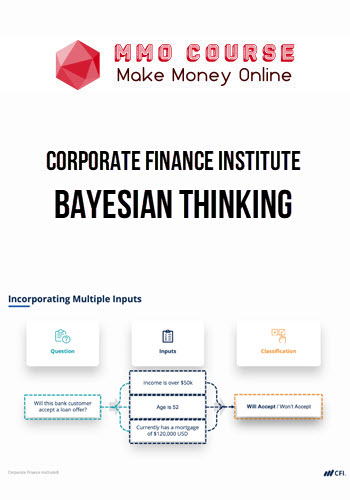Corporate Finance Institute – Bayesian Thinking
$997.00 $27.00
Delivery: Instant Delivery
Description
Corporate Finance Institute – Bayesian Thinking
Explore an alternative approach to probability with Bayesian Thinking for a deeper understanding of statistics to solve business problems.
- Better leverage your data for business insights with three different approaches to probability
- Predict the probability of future events and make better decisions by applying Bayes theorem
- Communicate your results more effectively by recognizing the benefits of your models and evaluating the results
Bayesian methods give us an alternative way to think about probability, with applications in business decision-making.
While traditional statistics requires us to observe a meaningful sample to inform decisions, Bayesian methods allow a “best guess” approach based on available information. These approaches also allow us to include other information such as beliefs and outside knowledge.
This course will take you on a step-by-step journey, from traditional statistical approaches, through conditional probability and Bayes Theorem. These concepts will form a foundation to help you understand two basic Machine-Learning examples introduced in the course. In the end, you’ll produce a real-world classification model using Python.
This Bayesian Thinking course is perfect for professionals who work with data and want to apply an understanding of statistics to solving business problems. This course covers critical concepts for anyone working with statistics or data science and introduces both the concepts and practical applications. No background in coding with Python is required for this course. Common career paths for students who take the BIDA™ program are Business Intelligence, BI Developer, Data Analyst, Quantitative Analyst, and other finance careers.
What You’ll Learn In Bayesian Thinking?
- Describe, compare, and contrast the three main approaches to probability
- Understand the fundamentals of the Bayesian approach—such as conditional probability, priors, and updating beliefs
- Apply Bayesian methods such as Bayes theorem and contingency tables to simple problems
- Describe two Bayesian machine learning methods—multinomial and gaussian Bayes classifiers
- Recognize the benefits of using these machine learning methods for modeling complex scenarios
- Evaluate the results of the machine learning tests against business goals in Python
Delivery Policy
When will I receive my course?
You will receive a link to download your course immediately or within 1 to 21 days. It depends on the product you buy, so please read the short description of the product carefully before making a purchase.
How is my course delivered?
We share courses through Google Drive, so once your order is complete, you'll receive an invitation to view the course in your email.
To avoid any delay in delivery, please provide a Google mail and enter your email address correctly in the Checkout Page.
In case you submit a wrong email address, please contact us to resend the course to the correct email.
How do I check status of my order?
Please log in to MMOCourse account then go to Order Page. You will find all your orders includes number, date, status and total price.
If the status is Processing: Your course is being uploaded. Please be patient and wait for us to complete your order. If your order has multiple courses and one of them has not been updated with the download link, the status of the order is also Processing.
If the status is Completed: Your course is ready for immediate download. Click "VIEW" to view details and download the course.
Where can I find my course?
Once your order is complete, a link to download the course will automatically be sent to your email.
You can also get the download link by logging into your mmocourse.hk account then going to Downloads Page.
Related products
Total sold: 5
Total sold: 4











